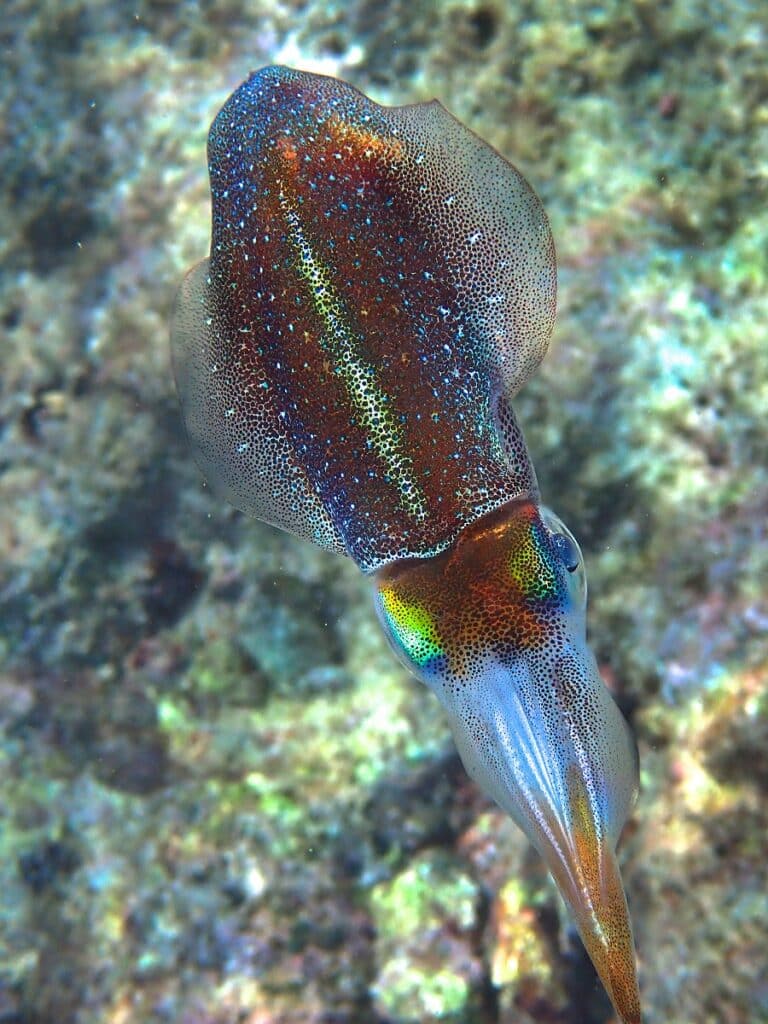Did you come across a pack of small, inquisitive and colorful squids while snorkeling in the Caribbean? You probably just met the Caribbean reef squid, one of my favorite species to spot in the shallows. Colorful and not too shy, they’re entertaining and fascinating to see.
Let’s have a closer look at this unusual squid species. Keep reading for everything you need to know about the Caribbean reef squid!
Caribbean reef squid appearance
When I first spotted a small group of Caribbean reef squids, I figured I’d stumbled upon a posse of strange cuttlefish. Nope! Although they sport similar undulating fins on the side of their torpedo-shaped body, these guys are absolutely squids. They form part of the family Loliginidae, the pencil squids.
These squids, which are scientifically known as Sepioteuthis sepioidea, have 10 arms in total. Eight are short, while two are long and feature suckers to help reel in prey. Their eyes are very large in comparison to their bodies.



Move over, chameleons…
Although it’s only about 8″ (20 cm) in length, the Caribbean reef squid is truly a mesmerizing sight to see. Its base color is brownish with shimmering speckles, but that can change if one of these squids feels threatened, spots members of its group or wants to mate. They can change color! If you approach a group while snorkeling, you’ll likely see them flash a range of hues and patterns.
Using chromatophores and iridiphores, skin color cells that can expand or retract to show different levels of color, the Caribbean reef squid and many other cephalopods can change their colors and patterns extremely rapidly. In the case of this species, they do so in order to help them communicate, flirt and for camouflage purposes.
The squids can take on a huge range of different appearances. One 2008 study, for example, refers to patterns like “‘eye spots’, ‘all brown’, ‘flashing’, ‘clear’, ‘plaid’ and ‘dark arms’”. A 2016 paper talks of “Zebra and Saddle-Stripe displays” being involved in the mating process, as well as an “on-off Flicker”. There are apparently around forty in total!
Did you know? Aside from its colors and patterns, the Caribbean reef squid also uses different postures to communicate.
| Name (common, scientific) | Caribbean reef squid, Sepioteuthis sepioidea |
| Family | Loliginidae |
| Spread | Caribbean Sea, Florida, Bahamas |
| Habitat | Shallow reefs & open waters |
Planning your next snorkel trip?
Caribbean reef squid habitat
As its name suggests, the Caribbean reef squid is common in the Caribbean Sea. It can also be found around Florida and the Bahamas.
While snorkeling, your best bet to spot them is in shallow reefs or hiding in tufts of turtle grass. They travel in shoals and can look like fish from a distance, but their movements give them away. The species is quite unique in the fact that it gets so close to the coast, especially during the day.
Although this species is known as “reef squid”, groups of adults can apparently be found at up to 100 meters. They go to these depths at night, likely to hunt for small fish and shrimp.
Caribbean reef squid facts
- These squids can shoot ink. As with many other cephalopods, this has been described as a defense mechanism to help the squid escape from predators. A 2008 study also suggested that it helps warn other group members of danger.
- The Caribbean reef squid is semelparous. After a complex mating ritual, in which the male woos the female with color changes and “dancing”, she stores his sperm. When she’s ready, she lays eggs and then promptly dies.
- Caribbean reef squids can fly. Or, well, they can glide, similar to flying fish. This made quite a stir when it was first observed by a marine biologist in 2001. It was known they can swim away quickly by shooting a jet of water, but flying…? However, the behavior has since been noted in a bunch of other squid species.
- These squid are sneaky hunters. According to observations, they can imitate seaweed to allow them to get close to their prey.
If you have any more questions about the Caribbean reef squid or if you’d like to share your own experiences with this colorful cephalopod, don’t hesitate to leave a comment below!
Sources/further reading:
Hanlon, R. (2007). Cephalopod dynamic camouflage. Current biology, 17(11), R400-R404.
Jabr, F. (2010, August 2). Fact or Fiction: Can a Squid Fly out of Water? Scientific American.
Williams, R. (2008). Caribbean Reef Squid, Sepioteuthis sepioidea, Coloration and Behavior.

